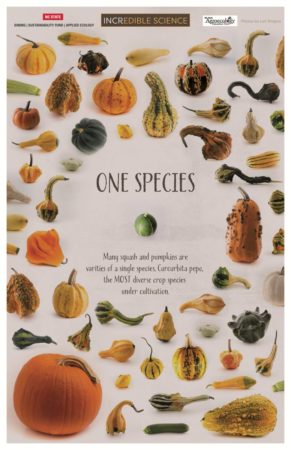- There’s a world of coloured sheep out there, and a conference.
- Not to mention camels.
- Does this cute sheep qualify as coloured?
- You can’t copyright a cheese in Europe. Worth a Brexit joke? No.
- Like board games? You’ll LOVE this.
- Speaking of games, the only thing qat is good for is to use up your Q in Scrabble. Which is why you won’t find it in the new CATAN, despite the tempting near-homophony.
- Learn about the SDG 2.5 indicators from FAO.
- Oh, and since you’re there, take a gander at their new biodiversity website.
- Climate change affecting potato production in New Zealand.
- I think I may have overlooked this CTA Dossier on underutilized crops and nutrition, which is naughty of me.
- Coaxing “cafe marron” to have sex with itself.
Nibbles: Australian wheat, Heirloom apple, Olive trouble, The Queen’s Mulberries, Watermelon breeding, Phancy phenotyping, Chefs & NUS, Cacao origins
- An encomium for CIMMYT Down Under.
- A paean for the Albemarle pippin. That’s an apple.
- A threnody for the Italian olive.
- An honour for British mulberries.
- A tribute to USDA watermelon genomics.
- An auto-panegyric from BASF. Yeah, I know auto is Latin, sue me.
- A celebration of millet-loving chefs.
- A reflection on the origin of that cacao origin paper, by the author.
Nibbles: CBD, NPGS, Greek celery, Rodomiro Ortiz interview, Amazonian fruits, In vitro, Maize archaeology, Asian seed companies, Victorian root
- Courtesy of Bioversity, useful summary of agricultural biodiversity events at the CBD COP, starting in a few days.
- The USDA National Plant Germplasm System, justified.
- The ancient symbolism of celery. Spoiler alert: death.
- A breeding professor calls for a major change in breeding. Spoiler alert: productivity is not enough.
- What’s the next açaí? And will it save the Amazon?
- Saving threatened species. Spoiler alert: seeds are not enough.
- 9000 years of maize history, decoded.
- The Access to Seeds Index 2019 report for South and Southeast Asia is out. Spoiler alert: I feel a guest post coming on.
- UK supermarket to stock salsify.
Brainfood: Climate resilient crops, Food system limits, Phenotyping double, Sweet sorghum, Melon history, Paying4data, Beercalypse, Village chickens, Breeding 4.0, European maize, Brachiaria ROI
- Are agricultural researchers working on the right crops to enable food and nutrition security under future climates? No. Well, kinda.
- Options for keeping the food system within environmental limits. You need to pursue several. Including those discussed above, presumably.
- Deep Learning for Plant Stress Phenotyping: Trends and Future Perspectives. 3D CNN architectures applied to hyperspectral imaging is the future, apparently.
- Dealing with multi‐source and multi‐scale information in plant phenomics: the ontology‐driven Phenotyping Hybrid Information System. You’re going to need a fancy system to keep track to the data from the above.
- Sweet Sorghum Originated through Selection of Dry, a Plant-specific NAC Transcription Factor Gene. Could be applied to other cereals?
- Repeated domestication of melon (Cucumis melo) in Africa and Asia and a new close relative from India. Once was not enough.
- Paying for Digital Information: Assessing Farmers Willingness to Pay for a Digital Agriculture and Nutrition Service in Ghana. Cheaper is better. There’s a shocker. Oh, and women are more careful with their money.
- Decreases in global beer supply due to extreme drought and heat. 32% decrease in consumption in Argentina, 193% increase in price in Ireland. But clearly the authors have never heard of sorghum beer.
- The role of local adaptation in sustainable production of village chickens. Location, location, location.
- On the Road to Breeding 4.0: Unraveling the Good, the Bad, and the Boring of Crop Quantitative Genomics. Beyond breeding on predicted phenotypes, it’s sort of breeding for predicted environments.
- Maize yields over Europe may increase in spite of climate change, with an appropriate use of the genetic variability of flowering time. You don’t even need Breeding 1.0, if you deploy existing diversity optimally.
- Got forages? Understanding potential returns on investment in Brachiaria spp. for dairy producers in Eastern Africa. Definitely worth a flutter.
Diversity for Halloween
I’m not sure if I agree with the assertion, but this is a really nice poster.
